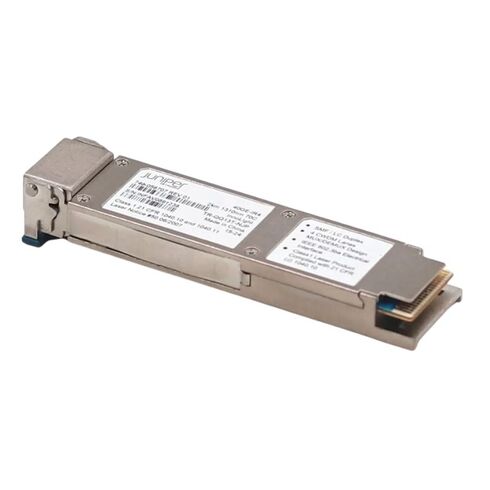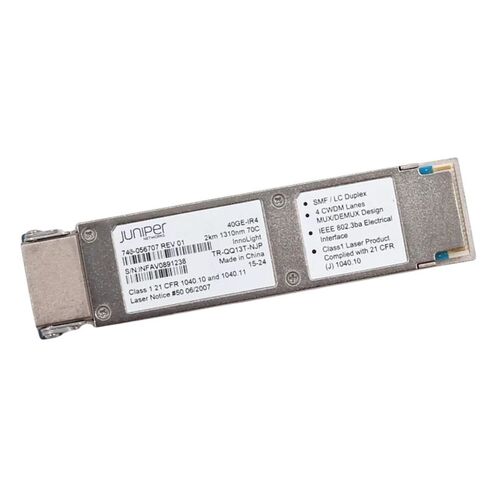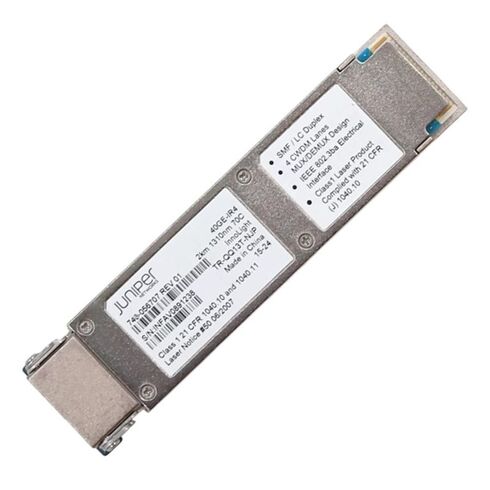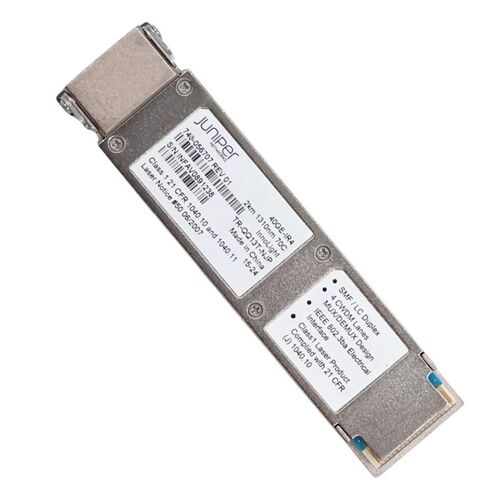740-056707 Juniper Networks QSFP+ 40G LC Duplex Transceiver 2km 1310nm SMF
- — Free Ground Shipping
- — Min. 6-month Replacement Warranty
- — Genuine/Authentic Products
- — Easy Return and Exchange
- — Different Payment Methods
- — Best Price
- — We Guarantee Price Matching
- — Tax-Exempt Facilities
- — 24/7 Live Chat, Phone Support
- — Visa, MasterCard, Discover, and Amex
- — JCB, Diners Club, UnionPay
- — PayPal, ACH/Bank Transfer (11% Off)
- — Apple Pay, Amazon Pay, Google Pay
- — Buy Now, Pay Later - Affirm, Afterpay
- — GOV/EDU/Institutions PO's Accepted
- — Invoices
- — Deliver Anywhere
- — Express Delivery in the USA and Worldwide
- — Ship to -APO -FPO
- — For USA - Free Ground Shipping
- — Worldwide - from $30
Product Summary
The Juniper Networks 740-056707 Qsfp+ is a high-performance optical transceiver designed for 40 Gigabit Ethernet applications. It is engineered to support long-distance data transmission over single-mode fiber (SMF) for distances of up to 1 kilometer.
Key Specifications
General Information
- Type: Optical Transceiver
- Data Rate: 40 Gigabit Ethernet
- Breakout Functionality: Not supported
Transceiver Details
- Transceiver Category: Qsfp+
- Connector Type: Duplex LC
Monitoring Features
- Monitoring Capability: Yes
- Digital Optical Monitoring (DOM): Available
Performance Attributes
Transmission Capabilities
This optical transceiver facilitates reliable and efficient data transmission, ensuring optimal performance for various network applications.
Distance Support
The device is capable of achieving up to 1 km of transmission range, making it suitable for extended network architectures.
Efficiency and Reliability
Designed for minimal signal loss and enhanced transmission integrity, this transceiver is ideal for high-bandwidth environments.
Compatibility and Integration
System Compatibility
The Juniper Networks 740-056707 Qsfp+ transceiver is compatible with various networking systems, ensuring seamless integration and enhanced functionality.
Use Cases
- Data Center Connectivity
- Enterprise Networking
- Telecommunications Infrastructure
Why Choose Juniper Networks?
Juniper Networks is renowned for its innovative networking solutions, offering products that meet the demands of modern data communication. This optical transceiver exemplifies their commitment to quality and performance.
Data Rate
The Juniper QSFP+ 40 Gbps LC Duplex Transceiver Transceiver is specifically designed to provide high-speed data transfer rates of up to 40 Gbps. This impressive data rate makes it ideal for use in high-demand networking environments, such as data centers and enterprise networks.
Benefits of 40 Gbps Data Rate
Enhanced Network Performance
With a data rate of 40 Gbps, this transceiver ensures smooth and efficient network performance. It allows for fast and reliable transmission of large amounts of data, enabling users to efficiently handle bandwidth-intensive applications and tasks without any bottlenecks or delays.
Increased Bandwidth Capacity
The high data rate supported by this transceiver significantly increases the available bandwidth capacity. This is crucial for organizations that require extensive data transmission and handling capabilities, as it allows them to accommodate more devices, users, and services on their network without compromising performance.
Seamless Connectivity for High-Speed Networks
By supporting a data rate of 40 Gbps, this transceiver ensures seamless connectivity for high-speed networks. Whether it's connecting servers, switches, or other network devices, this transceiver provides a reliable and efficient solution for transmitting data at lightning-fast speeds.
Importance of 40 Gbps Data Rate
Future-Proofing Network Infrastructure
Investing in a transceiver with a high data rate like 40 Gbps is crucial for future-proofing network infrastructure. As technology continues to advance and the demand for higher bandwidth increases, having a transceiver capable of supporting these high data rates ensures that your network will be able to handle future growth and requirements without the need for costly upgrades.
Enabling High-Performance Applications
Many modern applications, such as video streaming, cloud computing, and virtualization, require high-speed data transfer to function optimally. By utilizing a transceiver with a 40 Gbps data rate, users can take full advantage of these high-performance applications without experiencing any lag or performance issues.
Supporting Large-Scale Data Transfers
In today's data-driven world, organizations often need to transfer large amounts of data quickly and efficiently. Whether it's backing up critical data, replicating databases, or transferring files between different locations, a 40 Gbps data rate ensures that these large-scale data transfers can be completed in minimal time, improving productivity and reducing downtime.
Distance
The Juniper QSFP+ 40 Gbps LC Duplex Transceiver Transceiver offers a distance capability of up to 2km. This impressive distance allows for flexible network configurations and connectivity options, making it suitable for various networking environments.
Benefits of 2km Distance
Extended Network Coverage
With a distance capability of up to 2km, this transceiver enables network administrators to extend their network coverage over larger areas. This is particularly useful in scenarios where devices or network endpoints are located far apart but still need to be connected reliably.
Flexibility in Network Design
The 2km distance capability of this transceiver provides flexibility in network design. It allows network architects to design networks that cater to specific requirements and adapt to the layout of the infrastructure. Whether it's connecting devices within a building or establishing connections between multiple buildings, this transceiver offers the necessary flexibility.
Easier Network Expansion
When organizations grow or expand their operations, they often need to add new devices or expand their existing network infrastructure. The 2km distance capability ensures that network expansion can be easily achieved without the need for significant modifications or additional equipment. This reduces costs and simplifies the overall network management process.
Importance of 2km Distance
Connecting Remote Locations
In scenarios where remote locations need to be connected, the 2km distance capability of this transceiver becomes crucial. Whether it's connecting branch offices, data centers, or remote facilities, this transceiver provides the necessary reach to establish reliable and high-speed connections over extended distances.
Overcoming Physical Constraints
Certain physical constraints, such as distance limitations imposed by the infrastructure or geographical factors, can pose challenges when establishing network connections. The 2km distance capability of this transceiver helps overcome these constraints, ensuring that network connectivity can be achieved regardless of the physical environment.
Facilitating Network Scalability
As organizations grow and their network requirements increase, scalability becomes a critical factor. The 2km distance capability allows for easy scalability, as it provides sufficient reach to connect additional devices and expand the network seamlessly. This ensures that network infrastructure can keep up with evolving business needs.
Wavelength
The Juniper QSFP+ 40 Gbps LC Duplex Transceiver Transceiver operates at a wavelength of 1310nm. This specific wavelength offers several benefits in terms of network performance, compatibility, and ease of implementation.
Benefits of 1310nm Wavelength
Optimal Signal Quality
Operating at a wavelength of 1310nm ensures optimal signal quality for data transmission. This wavelength is known for its ability to minimize signal degradation and attenuation, resulting in reliable and high-performance network connections. Users can expect consistent and stable data transmission without any loss in quality or performance.
Broad Compatibility
The 1310nm wavelength is widely supported by various networking equipment and infrastructure. It is a standard wavelength used in many fiber optic systems, making this transceiver highly compatible with a range of devices and network setups. This ensures seamless integration into existing network environments without the need for additional modifications or upgrades.
Easy Implementation
With the 1310nm wavelength, implementing this transceiver into a network is straightforward and hassle-free. Network administrators can easily connect the transceiver to compatible devices without requiring any complex configuration or specialized expertise. This allows for quick deployment and reduces the time required for network setup and maintenance.
Importance of 1310nm Wavelength
Fiber Optic Infrastructure Compatibility
The 1310nm wavelength is commonly used in fiber optic infrastructure, making it essential for ensuring compatibility with existing network setups. By using a transceiver that operates at this wavelength, users can seamlessly integrate the transceiver into their fiber optic networks, leveraging existing infrastructure without the need for costly upgrades or replacements.
Interoperability with Standard Equipment
The 1310nm wavelength is part of the standard range supported by most networking equipment manufacturers. This ensures interoperability with a wide range of devices, switches, and routers, allowing for easy integration and connectivity. Users can confidently use this transceiver with various networking components, knowing that it will work seamlessly within their existing network ecosystem.
Flexible Deployment Options
Operating at the 1310nm wavelength provides flexibility in deployment options. Users can choose from a wide range of compatible fiber optic cables and connectors to establish connections between devices. This flexibility allows for customized network configurations based on specific requirements, ensuring optimal performance and reliability.
Fiber Type
The Juniper QSFP+ 40 Gbps LC Duplex Transceiver Transceiver supports Single-Mode Fiber (SMF) type. This fiber type offers several advantages in terms of longer transmission distances, higher bandwidth capacity, and lower signal loss.
Benefits of SMF Fiber Type
Longer Transmission Distances
Single-Mode Fiber (SMF) enables longer transmission distances compared to other fiber types. This is due to its narrower core, which allows for less dispersion and signal loss over longer distances. Using this transceiver with SMF ensures that data can be transmitted reliably over extended distances without compromising signal integrity.
Higher Bandwidth Capacity
SMF provides higher bandwidth capacity compared to Multi-Mode Fiber (MMF). This means that more data can be transmitted simultaneously, making it suitable for high-demand networking environments where large amounts of data need to be transferred quickly and efficiently. The higher bandwidth capacity ensures that the network can handle increased data traffic without any performance degradation.
Reduced Signal Loss
SMF offers lower signal loss compared to MMF. This means that data signals can travel further without experiencing significant degradation or attenuation. Lower signal loss translates into improved network performance and reliability, ensuring that data transmission remains stable even over long-distance connections.
Importance of SMF Fiber Type
Supporting Long-Distance Networking
In scenarios where long-distance networking is required, such as connecting different buildings or establishing connections between remote locations, SMF becomes essential. The use of this transceiver with SMF ensures that data can be transmitted over extended distances without compromising signal quality or reliability.
High-Performance Data Transmission
The higher bandwidth capacity provided by SMF allows for high-performance data transmission. Whether it's transferring large files, streaming high-definition media, or running bandwidth-intensive applications, the use of SMF ensures that users can leverage the full potential of their network infrastructure without experiencing any bottlenecks or performance limitations.
Future-Proofing Network Infrastructure
Investing in a transceiver that supports SMF fiber type is crucial for future-proofing network infrastructure. As data demands continue to increase, having a fiber type that can handle higher bandwidth capacities and longer transmission distances ensures that the network will be able to adapt to future growth and requirements without the need for costly upgrades or replacements.
Part Number
The Juniper QSFP+ 40 Gbps LC Duplex Transceiver Transceiver has a part number of 740-056707. This unique identifier is essential for accurately identifying and sourcing the correct transceiver model, ensuring compatibility and seamless integration into the network.
Benefits of Part Number
Easy Identification and Sourcing
The part number serves as a unique identifier for the specific transceiver model. It allows network administrators and IT professionals to easily identify the correct transceiver needed for their network setup. Additionally, having a part number simplifies the sourcing process, as it ensures that the exact model can be obtained from reliable suppliers or manufacturers.
Compatibility Assurance
By using the correct part number, users can ensure compatibility with their networking equipment and infrastructure. Each transceiver model may have specific features or specifications that make it suitable for certain devices or applications. Accurately identifying the part number guarantees that the transceiver will work seamlessly within the existing network ecosystem without any compatibility issues.
Seamless Integration into Network Inventory
Keeping track of network inventory is essential for efficient network management and maintenance. Having a part number associated with each transceiver simplifies inventory management, as it ensures accurate identification and tracking of each unit. This allows for seamless integration into existing inventory systems, making it easier to monitor and manage transceivers throughout their lifecycle.
Importance of Part Number
Avoiding Compatibility Issues
Using the correct part number eliminates the risk of compatibility issues when integrating the transceiver into the network. It ensures that the transceiver is specifically designed to work with the intended devices, switches, or routers, guaranteeing seamless integration and optimal performance.
Efficient Network Maintenance and Troubleshooting
Having a part number associated with each transceiver simplifies network maintenance and troubleshooting procedures. It allows network administrators to quickly identify and locate specific transceivers when performing maintenance tasks or resolving issues. This saves time and effort, enabling faster resolution of network problems and minimizing downtime.
Streamlined Warranty and Support Processes
In case of warranty claims or support requirements, having the correct part number is essential. It ensures that manufacturers or suppliers can accurately identify the specific transceiver model and provide the necessary assistance or replacement. This streamlines warranty and support processes, reducing delays and ensuring a smoother customer experience.













